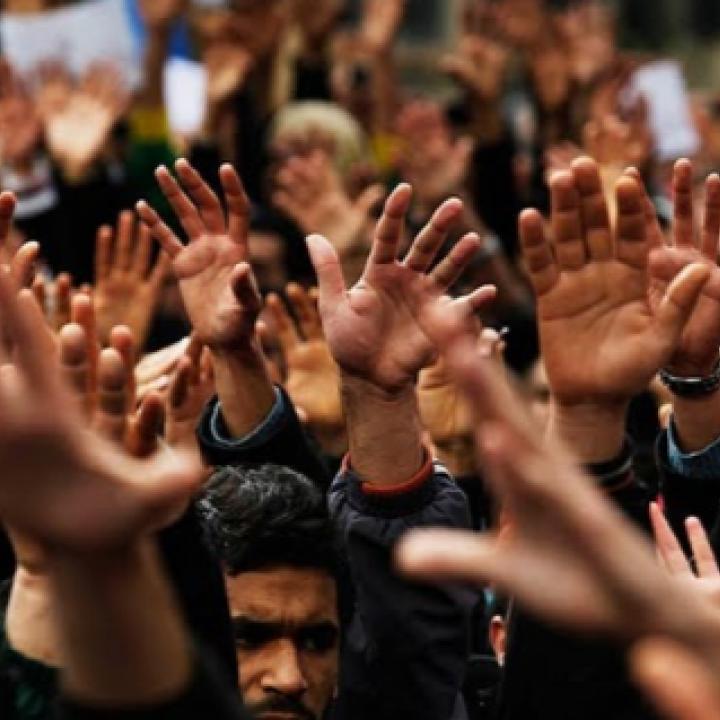
Can Diversity in the Middle East Be Rescued?

May 5, 2017
A few decades ago, Egypt, Syria, and Iraq were culturally rich and diverse societies, with distinct national identities that acknowledged their pluralism. For much of the twentieth century the Egyptian flag was green with a white crescent encircling three white stars. A relic of Ottoman times, the flag had been re-interpreted upon independence with the crescent representing the nation and the stars representing its three main religious traditions: Muslim, Christian, and Jewish. National identity, accordingly, both transcended and protected communal ones. Baghdad early in the twentieth century was one third Muslim, one third Christian, and one third Jewish. In Syria, up until the war, Aleppo remained a city not of a single majority but of religious and ethnic diversity — Arab, Kurdish, Syriac, Armenian, Turkmen, and more, of both Muslim and Christian faiths.
Today, both Syria and Iraq have become merely notional states harboring feuding communities set to deny the diversity of the recent past in any consideration of future peace. Even Egypt, arguably the oldest nation-state on the planet, seems to be undergoing an identity transformation, with the last bastion of religious diversity within it under threat. It is hard to imagine that the precarious orders in Lebanon and Jordan will be able to survive as havens of pluralism if the current trajectories set for Egypt, Syria, and Iraq continue. Whether diversity can be saved in the Arab Middle East is an ominous question with implications as grave as the raging, ongoing battles. The answer might not be as dire as feared by the news cycle; it may require, however, a longer-term approach that currently does not appear to have much support.
It may be in Egypt, the most populous, and by relative terms, the most stable, of the three countries at risk, where the issue of diversity ought to be first considered. The issue of diversity should first be considered in Egypt, the most populous, and by relative terms the most stable of the three countries most at risk.
Christian Egyptians are a recently declared target for the so-called Islamic State terror organization. In Sinai, a brutal campaign of murder and intimidation has forced families to flee, while in Cairo and later in Tanta and Alexandria suicide attacks on churches have claimed scores of lives. As damaging as these actions have been, the narrative associated with the crime raises concerns beyond the hard security approach that the Egyptian government has adopted to address the issue.
As part of a project of locally-driven and European-assisted modernization in the nineteenth century, Christians in Egypt were able to slowly and incrementally overcome second-class status. Official administrative adjustments were reinforced by a gradual shift towards recognizing Egyptian Copts as fellow natives, in common cause with Egyptian Muslims against the greed of the colonial powers, non-indigenous ruling elites, and expatriate communities. The past century witnessed Egypt relieving itself of these layers. The popular uprising against the British in 1919 marked the first victory in an anti-colonial drive. In 1952, the Free Officers coup deposed a monarchy that had maintained a centuries-old model of rule over the natives by foreign elite. The 1950s also saw the mass expulsion of non-national communities and even nationals without Egyptian citizenship. Communities that had been instrumental in the ascent of Egypt as a modern state and society - Greeks, Armenians, Levantines, Jews, and various Europeans - were unceremoniously invited to leave. The Copts, as a collective, implicitly became the new Other, on account of their general resistance to the new Arab identity that Egypt sought in the 1960s in its quest for regional prominence. In public discourse, enmity towards Jews, recast as anti-Zionism, obfuscated the growing internal schism by nurturing a “the enemy is outside” narrative. The peace accord with Israel in 1978 and its aftermath altered the argument, but not the intensity, of the anti-Jewish expressions; with anti-Zionism no longer officially sanctioned, rhetoric was more classically anti-Semitic. However, the price of this rise in nationalism, counterproductively, was the promotion of a model in which the Egyptian identity was highlighted as increasingly Muslim. Long before the Islamic State acted on its ideological claim that Copts are “infidel combatants” (kuffar harbiyyun), deliberately or inadvertently Egyptian ideologues of many stripes had prepared the framework for the exclusion of Copts from the national identity.
Subsequent to the church attacks in Tanta and Alexandria, fingers pointed at the al-Azhar religious establishment for its alleged responsibility in enabling violent extremism. Textbooks used at al-Azhar, some claimed, endorse, or even command, aggressive actions against non-Muslims in certain situations and in accordance with particular rules. Al-Azhar, as custodian of the scholastic tradition, is long overdue to reconsider the texts still in use; were such a revision to happen, however, it would likely be technical and of limited impact. The current head of al-Azhar, Shaykh Ahmad al-Tayyib, is a self-proclaimed centrist who has endeavored to highlight his institution’s efforts at inter-faith respect as a means to achieve inter-community coexistence. He has thus maintained a cordial and productive rapport with Tawadros II, Pope of the Coptic Church. Al-Tayyib’s engagement of Pope Francis, whom he visited at the Vatican a year ago and recently welcomed in return in Egypt, may represent the apex of what can be reasonably expected from al-Azhar.
A more pertinent question that the loud calls for religious reform fail to address, however, is why it is incumbent on a religious institution to produce a vision of national accord.
It is highly unlikely that al-Azhar would be able to deliver an antidote to militant radicalism anytime soon. This is not an inherent limitation of Islam, but a product of current conditions. In the partial acquisition of modernity, the religious tradition has become over-textualized and thus less flexible and more bound by precedent. More important than the shortcomings of religious institutions, however, is the fact that national projects have failed to deliver on their promises of progress, prosperity, and dignity, and have woefully derailed a once promising effort for an education renaissance.
The modern Arab state, with Egypt as a standard bearer offered a social compact through which the citizenry forfeited political rights in exchange for the promise of services provided by the state, including health, education, and employment. Statist and socialist visions dictated that employment would be under the auspices of government. Schools and universities gradually became degree factories, throwing away considerable accomplishments secured in previous decades towards innovation and progress in both the arts and the sciences. Religious learning and concerns did not invade and conquer the realm of secular education and public conversation; they merely occupied a vacated space.
Herein may lie a path to recovery, for diversity and for a national commonwealth. Not in reactive calls to religious reform, but in a re-invigoration of useful secular education, as part of a cycle leading towards progress and ultimately prosperity. Safeguarding the remnants of diversity, in Egypt and across the Middle East, may not require a reformed religious discourse but a gradual reclaiming of the secular space surrendered to religious discourse through the gutting of education. This is not a call for a secularist order, associated in recent Arab experiences with dictatorship and coercive measures. It is instead a call for the recognition of the need for cultural security. In addition to the expectation of personal and material security, citizens of the Arab Middle East are entitled to cultural security: the assurance that their faith, customs, and way of life are not targeted for elimination — neither by the state nor by hostile non-state actors.
The model to serve as a guide is not entirely unlike early independent Egypt, Syria, and Iraq, where the state, whether monarchy or republic, was understood as an over-arching level of identity that protects, and does not obliterate, any underlying communitarian identity. That early liberalism was ill-equipped to meet the socio-economic needs and expectations of the general population. It was deemed elitist by its detractors, and was challenged by populism. In each of these three major Arab societies populism cleared the way for nationalism, with diversity viewed as a weakness. But the subsequent grand narratives, from nationalism to Islamism, have failed even more dramatically in meeting the expectations of prosperity. It is time to rescue diversity by reversing the steps that curtailed its fulfillment.
Evidently, this is neither an independent approach, since it requires a purposeful economic recovery, nor is it a quick fix. But the approach, to be fleshed out and elaborated upon, is one in which Egypt, and ultimately Iraq and Syria, as polities and government institutions, would refrain from the reforming Islam, leaving such a task for organic Islamic thinking, and would instead engage instead in a correction to regain the path to prosperity that was conceived in an earlier liberal age.


